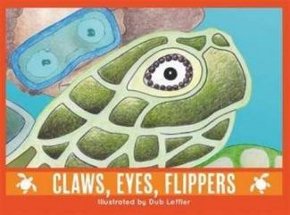Deadly reads

Saltwater series. Magabala Books, 2012.
(Ages 3-5) Aboriginal themes, Readers, Warmly recommended. This
series of four titles is aimed at indigenous and non indigenous
children, with their short sentences, range of words and bright
attractive illustrations. They are levelled so will be easily
selected by teachers and parents. Written and illustrated by
Aboriginal authors and artists, the stories are culturally sound and
appropriate, with illustrations that clearly reflect our Aboriginal
heritage. The words used have been specifically chosen to expand the
child's vocabulary, increasing in complexity as the stories proceed.
Claws, eyes, flippers ill. by Dub Leffler (ISBN 978 1 921248
74 0
shows the similarities and differences between two animals, the crab
and the turtle. Each has eyes, and these are quite different, and
each have arms, but in one they are called claws and the other,
flippers. In four short sentences, the similarities and differences
between these two Australian coastal animals is shown, with clear,
colourful illustrations that not only show where they live, but also
how we might see them.
Animals move, ill. by Dub Leffler (ISBN 978 1 921248 75 7)
Four animals, a crab, dolphin, bird and fish are shown moving within
their environment. Four short sentences give the name for their
movement, and the illustrations show the animal in its environment
and how we might see it.
A beach for us to play by Nola Turner-Jensen, ill. by Maggie
Prewett
(ISBN 9781 921248 76 4)
The family on the beach shows the reader all the things they are
doing on the beach, looking at shells, flying a kite, playing with a
bucket, building a campfire to make damper, swimming and then
fishing which results in a crab and a fish to cook and eat. Each of
the things to do is shown with bright illustrations while the short
sentences bring the story to a close with a shared meal. A happy
sharing family using their environment to have fun and catch food.
I have ... by Nola Turner-Jensen, ill. by Maggie Stewett
(ISBN 978 1 921248 77 1) Maggie shows us parts of her body (arms,
legs and toes) and these are contrasted with those of animals she
sees in her environment. When she says that she has arms, the turtle
says he has flippers, so leading the reader into making sure that
they have an understanding of the correct terms for the animal's
appendages. The humour in the last page will not escape the reader's
attention.
Fran Knight